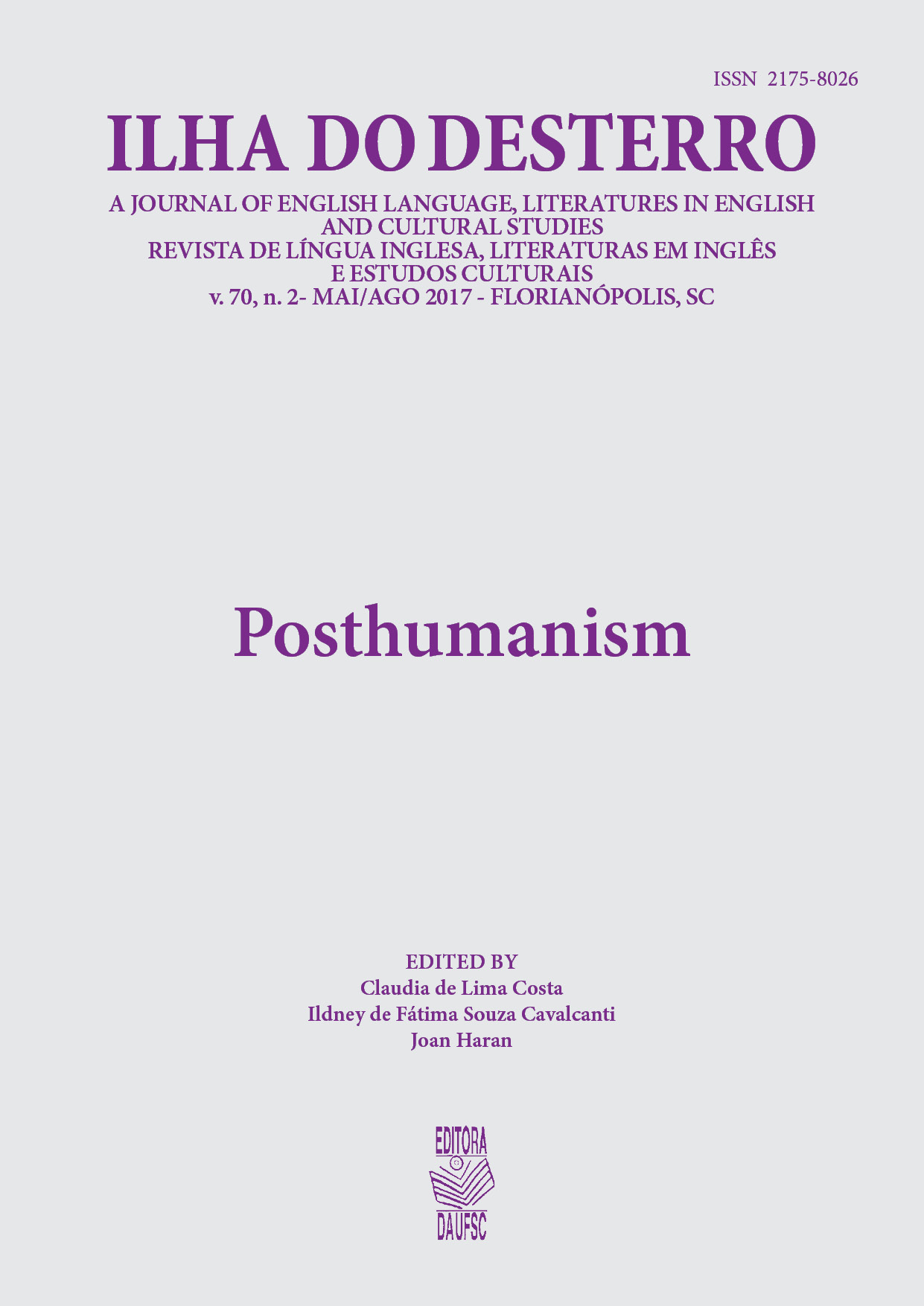Inventário Poético: Anotações sobre os resíduos do humano na literatura
DOI:
https://doi.org/10.5007/2175-8026.2017v70n2p53Resumo
Este ensaio pretende dissertar sobre o texto de ficção eletrônica de Richard Holeton – Frequently Asked Questions About “Hypertext” – publicado por N. Katherine Hayles na Eletronic Literature Collection (vol. 1, 2006), obra que fornece um rico material para leituras “pós-humanistas” sobre o futuro da poesia como um locus privilegiado de expressão anímica. Trata-se de uma releitura irônica de um texto parodístico de autoria de Vladimir Nabokov: Pale Fire (1962). Ao contrário do que sugere o título, porém, o texto de Holeton não se apresenta como um ensaio acadêmico sobre a escrita digital, mas como um poema experimental sujeito aos mirabolantes exercícios analíticos de diversos críticos fictícios, praticantes de algumas linhas dos atualmente populares Estudos Culturais. A obra possibilita ao leitor uma reflexão bem-humorada sobre os perturbadores desdobramentos da escrita, da leitura e da produção de conhecimento na contemporaneidade.
Referências
BALPE, J.P. La Tentation de L'infini. In: Études Romanesques, n. 1, 1993, p. 33-40.
_______. Littérature Numérique, Contraintes et Ouvertures de L’Écran: Du Stylo à L’Ordinateur ou Du Livre à L’Écran (2004). Disponível em:
http://www.brown.edu/Research/dichtungdigital/2004/3/Balpe/index.htm
_______. Pour une Littérature Informatique: un Manifeste..., in: VUILLEMIN, Alain; LENOBLE, Michel. Littérature et Informatique: La Littérature Générée Par Ordinateur. Arras: Artois Presses Université, 1995, p. 19-32.
_______. Principles and Processes of Generative Literature: Questions to Literature (2005). Disponível em: http://www.brown.edu/Research/dichtungdigital/2005/1/Balpe/index.htm
BAUMAN, Sygmunt. Modernidade Líquida. Rio de Janeiro: Zahar, 2001.
BARROS, Manoel de. Poesia Completa. São Paulo: Leya, 2010.
BENJAMIN, Walter. Experiência e Pobreza, in: Magia e Técnica, Arte e Política. São Paulo: Brasiliense, 1987.
BLANCHOT, Maurice. O Livro por Vir. São Paulo: Martins Fontes, 2005.
BLOOM, Harold. O Cânone Ocidental. Rio de Janeiro: Objetiva, 1995.
_____. A Angústia da Influência. Uma Teoria da Poesia. Rio de Janeiro: Imago, 1991.
BORGES, Jorge Luis. Ficções. São Paulo: Globo, 1989.
CALVINO, Ítalo. Se um Viajante numa Noite de Inverno. Rio de Janeiro: Nova Fronteira, 1982.
DÄLLENBACH, Lucien. El Relato Especular. Madrid: Visor Distribuciones, 1991.
ELETRONIC LITERATURE ORGANIZATION. What is E-lit. Disponível em: <http://eliterature.org/what-is-e-lit/>
ECO, Umberto. Interpretação e Superinterpretação. São Paulo: Martins Fontes, 1993.
FISH, Stanley. “Como Reconhecer um Poema ao Vê-lo?”, in: PaLavra. Revista da PUC-Rio, Departamento de Letras, n. 1, 1993.
_____. Is There a Text in this Class? Cambridge: Harvard University Press, 1980.
GAGGI, Silvio. From Text to Hypertext: Decentering the Subject in Fiction, Film, The Visual Arts and Electronic Media. Philadelphia: University of Pennsylvania Press, 2015.
GENETTE, Gerard. Palimpsesto. A Literatura de Segunda Mão. Belo Horizonte: Viva Voz, 2010.
HAYLES, N. Katherine. Literatura Eletrônica: Novos Horizontes para o Literário. Tradução Luciana Lhullier e Ricardo Moura. São Paulo: Global; Fundação Universidade de Passo Fundo, 2009.
_____. How We Became Posthuman. Virtual Bodies in Cybernetics, Literature and Informatics. Chicago and London: The University of Chicago Press, 1999.
HOLETON, Richard. Frequently Asked Questions About “Hypertext”, in: Eletronic Literature Collection, a publication of The Eletronic Literature Organization (ELO), Vol. 1 (2006). Disponível em: http://collection.eliterature.org/
LE BRETON, David. Adeus ao Corpo, in: NOVAES, Adauto (Org.). O Homem-Máquina. A Ciência Manipula o Corpo. São Paulo: Companhia das Letras, 2003.
LANDOW, George P. Hipertexto 3.0: La Teoria Crítica y Los Nuevos Médios em uma Época de Globalización. Barcelona: Paidós Ibérica, 2009.
LÉVY, Pierre. As Tecnologias da Inteligência. São Paulo: Editora 34, 1993.
LINS, Osman. A Rainha dos Cárceres da Grécia. São Paulo: Melhoramentos, 1976.
MIRANDA, Fabiana Móes. Fandom: Um Novo Sistema Literário Digital. In: FERREIRA, Ermelinda Maria Araújo (Org.). Intersecções: Ciência e Tecnologia, Literatura e Arte. Recife: Edufpe, 2009.
MOTTE, Warren. Oulipo. A Primer of Potential Literature. London: Dalkey Archive Press, 2007.
NABOKOV, Vladimir. Fogo Pálido. Rio de Janeiro: Guanabara, 1985.
_____. Pale Fire. London: Penguin, 1987.
NOVAES, Adauto (Org.). O Homem-Máquina. A Ciência Manipula o Corpo. São Paulo: Companhia das Letras, 2003.
PERRONE-MOISÉS, Leyla. Altas Literaturas. São Paulo: Companhia das Letras, 1998.
SAWAYA, Márcia Regina. Dicionário de Informática e Internet. São Paulo: Nobel, 1999.
SILVA, K. de F. Literatura Generativa: Múltiplas Trajetórias, in: Texto Digital. Florianópolis, ano 2, n. 2, Dezembro/2006.
Publicado
Edição
Seção
Licença
A revista Ilha do Desterro publica artigos e resenhas inéditos, referentes as áreas de Inglês, Literaturas em Língua Inglesa e Estudos Culturais. Publica volumes mistos e/ou temáticos, com artigos e resenhas em inglês e português.
Autores mantém os direitos autorais e concedem à revista o direito de primeira publicação, com o trabalho simultaneamente licenciado sob a Licença Creative Commons Attribution que permite o compartilhamento do trabalho com reconhecimento da autoria e publicação inicial nesta revista.

This work is licensed under a Creative Commons Attribution 4.0 International License.



